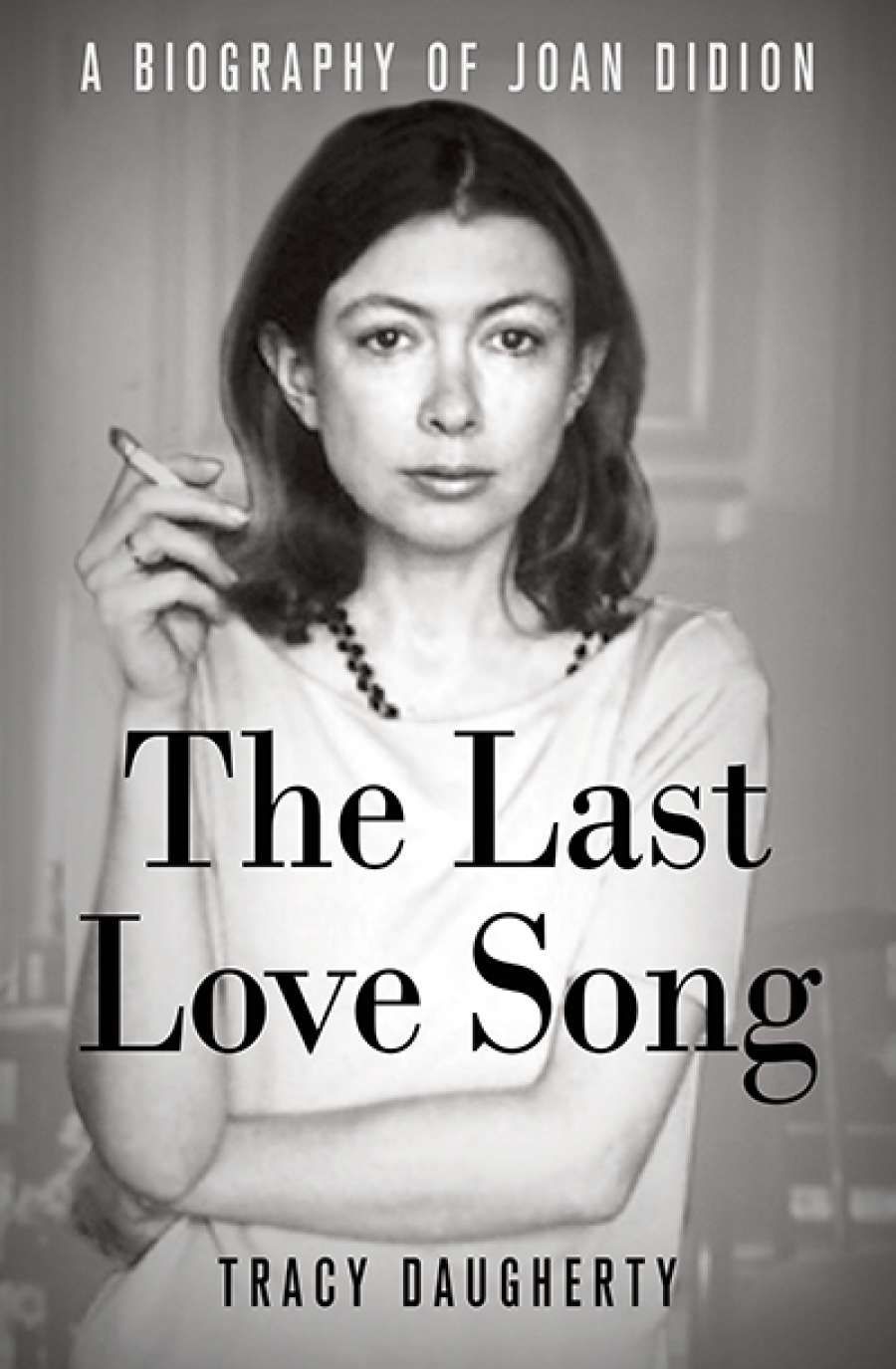
- Free Article: No
- Contents Category: Biography
- Custom Article Title: Kevin Rabalais reviews 'The Last Love Song: A biography of Joan Didion' by Tracy Daugherty
- Custom Highlight Text:
For many young writers, Julian Wasser's 1968 Time magazine photograph of Joan Didion posed in front of her yellow Corvette remains the epitome of cool ...
- Book 1 Title: The last love song
- Book 1 Subtitle: A biography of Joan Didion
- Book 1 Biblio: St Martin’s Press $54.99 hb, 752 pp, 9781250010025
Didion's work always starts on the periphery and moves – stealth-like, with lightning-quick observations – steadily inward. When writing about Patty Hearst, 'She looked for an out-of-the-way anecdote, seemingly insignificant, channelling all of California,' writes Daugherty. '[T]he pioneer experience in its modern manifestations; the historical imperative; the chain of forces shaping [her subject] ...' The style and structure of The Last Love Song strive to fit its subject. Throughout, Daugherty examines the cultural and political fluctuations – New Hollywood, public dissent over the Vietnam War, the rise of Reagan, among others – with the same detail and research with which he addresses his subject's work and life.
The life served the work itself. With her husband, the writer John Gregory Dunne, Didion led a peripatetic existence. Considered by the mid-1970s to be 'the new voices of Californian literature', Didion and Dunne retained separate careers while collaborating on screenplays including The Panic in Needle Park (1971) and A Star is Born (1976). There flared, writes Daugherty, 'the stresses of writing, money, lots of drinking, Dunne's quickness to anger, and Didion's "theatrical temperament ..."' Daugherty gives Dunne his share of time as he examines a marriage that grew less strained as their collaborative work increased.
Despite intensive research and knowledge of his subject and her time, The Last Love Song often seems workmanlike. Daugherty mines for drama in the life, but Didion gave everything to the page. Her persona, and the reason we return to her books, has more to do with voice and insight than with her personal life. Daugherty, biographer of Donald Barthelme (2009) and Joseph Heller (2011), strives to balance these private and public images. At his best, however, he makes us eager for Didion's voice. 'Style is character,' as she wrote in an essay on Georgia O'Keeffe. For Didion's many readers, therefore, the image of the woman in front of the yellow Corvette has become inseparable from the seductive powers of an inimitable prose style.
 Joan Didion in her yellow Corvette, Los Angeles 1970 (photograph by Julian Wasser, The LIFE images Collection/Getty Images)
Joan Didion in her yellow Corvette, Los Angeles 1970 (photograph by Julian Wasser, The LIFE images Collection/Getty Images)
In that style, as Daugherty writes, 'She helped us admit things we intuited but rarely aired: the fragility of our national myths and the constant nearness of death.' She moved from the fragmented prose and narratives of an early career to a fractured style that runs through the work published after A Book of Common Prayer. The tension of reading that novel or Play It as It Lays or Democracy (1984) comes through the prose that seeks to cut and prod the reader. 'The shape of her writing ... suggested the chaos of contemporary circumstances,' writes Daugherty. At its best, it produces the kind of physical effect that great writers have on us. At its worst – and this is more notable in her fiction than in the nonfiction – it reads like the work of someone 'who doesn't know what else to do with all that talent and skill', as Lore Segal observed of Play It as It Lays.
In recent years, Didion's work has focused on mortality and loss. Her books about the deaths of Dunne and their adopted daughter – The Year of Magical Thinking (2005) and Blue Nights (2011) – are among what Daugherty, along with many critics and readers, consider the 'masterpieces' of a singular career. There and elsewhere we witness a writer struggling with the tensions that infiltrate her pages. Her voice is at once uncertain and eager to let us know, as she writes in The White Album, 'precisely who I am and where I am and what is on my mind'.
 Joan Didion and John Gregory Dunne (AP Photo)
Joan Didion and John Gregory Dunne (AP Photo)
'A writer forms her stories,' writes Daugherty, 'but the opposite is also true. This is especially the case with Joan Didion, whose prime subject is the nature of narrative ...' We read The Last Love Song to understand a woman who captured, perhaps better than any other writer of her generation, the narrative of her times. We come away from Daugherty's biography knowing that we will find more about the woman and those times in the work that she produced. 'We tell ourselves stories in order to live,' Didion writes at the beginning of her essay 'The White Album'. For more than fifty years, that work has helped us to understand what we live and experience.


Comments powered by CComment